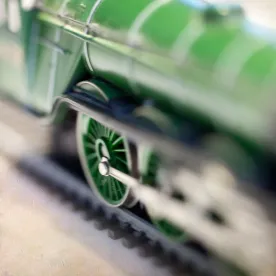The removal of diesel trains from operation in the UK could be accelerated as part of the UK government's plans to reduce carbon emissions.
In a speech in February 2018, the UK’s then-Minister of State for rail, Jo Johnson (brother of UK Prime Minister Boris Johnson), stated that he “would like to see us take all diesel-only trains off the track by 2040”. However, less than two years later in October 2019 (and during a week when attention was focussed on whether Prime Minister Johnson would reach agreement with the European Union on Brexit), Secretary of State for Transport Grant Shapps told the Parliamentary Transport Select Committee that “when I look at my comments on cars where, at the moment, the policy is 2040 to end the sale of petrol and diesel [cars], I recently said that I am going to investigate 2035. I am of course very interested in the earlier extinction of diesel trains”.
Shapps also shared with the Select Committee his views on certain bi-mode trains (i.e., trains with two different power sources), stating that “[n]othing frustrates me more … than hearing that there is a new bi-mode train about to be bought … and when you ask what the two modes are, it is not as you had hoped, electricity and hydrogen, but electricity and diesel … we have to end that …”. This raises the possibility of a ban on bi-mode trains using diesel as one source of power in addition to the potential ban on trains powered solely by diesel referred to by Johnson.
If they are indicative of a changed attitude within the UK government, Shapps’ comments are significant given that electric and diesel bi-mode trains have been considered by the UK government to be an important part of its rail improvement strategy. In July 2017 for example, Shapps’ predecessor as Secretary of State, Chris Grayling, made a statement to the UK parliament identifying bi-mode trains as one of the “the best available technologies to improve” the UK rail network. This was because such trains offer “seamless transfer from diesel power to electric that is undetectable to passengers” and eliminate the “need to electrify every line to achieve the same significant improvements to journeys”.
Climate change targets and the rail sector
Following a June 2019 amendment to UK’s Climate Change Act, the UK is now committed to ‘net zero’ carbon emissions by 2050 (compared with the previous target of at least 80% reduction from 1990 emissions’ levels by the same date). Moving journeys – both car and air – onto rail can reduce carbon emissions and, as between diesel and electric trains, diesel trains’ emissions can be twice as high.
There are also a number of very positive other technological advances being made in the rail sector which could contribute to the UK meeting its 2050 emissions target – in addition to hydrogen fuel cells, electric batteries are another option. Of course, how electricity stored in batteries is generated is relevant to their potential to reduce carbon emissions: electricity generated from renewables is obviously more environmentally friendly than electricity generated from gas or coal (although the percentage of electricity generated from coal in the UK is low and falling).
While hydrogen was identified by Shapps as a suitable replacement for diesel, there is currently limited infrastructure in the UK – as with other countries – for refuelling hydrogen fuel cells. While efforts are underway in Europe (such as the European Commission’s HyLAW project) to remove legal barriers to the deployment of fuel cells and hydrogen applications, there is an obvious need for governments to incentivise private sector investment. Shapps’ comments, if they are not followed up by government action, may therefore not lead to any significant practical developments in the UK.
Issues affecting the removal of diesel trains
The UK rail industry faces a number of significant issues with accelerating the removal of diesel trains and now possibly also with the use of diesel as one power source for bi-mode trains:
-
While some countries have fully electrified rail networks, in the UK less than half (around 43%) of the network is electrified (putting the UK well behind the Netherlands (76%), Italy (71%), and Switzerland (almost 100%));
-
Some UK electrification projects have overrun their budgets very considerably (and the associated work can also be very disruptive to travellers, as well as having a visual impact on the areas through which rail lines pass);
-
The scaling back of official electrification ambitions (including seemingly as a result of the perception within the UK government that bi-mode train technology meant that journeys could be improved without the need for costly electrification work);
-
Almost 30% of passenger trains are currently diesel-based. and these will largely need to be replaced by other self-powered trains to maintain capacity on the rail network;
-
Concerns, including those raised by the UK’s National Audit Office, in relation to pursuing, for example, a bi-mode approach without full analysis of the costs and benefits, including the increased wear and tear to track of heavier bi-mode trains, higher maintenance costs due to their two-mode operation, and greater environmental impact as compared with purely electric trains; and
-
While many journeys made by trains powered by hydrogen fuel cells or batteries, such as local trains that make frequent stops, are conceivable, even leaving aside the infrastructure issues, such technologies appear to be less suitable for high-speed inter-city and freight services.
Technical and financial challenges
There is already a general shortage of certain types of diesel rolling stock in the UK. Any change in UK government policy would likely exacerbate existing issues in relation to financing new and replacement diesel trains (whether diesel only or bi-mode).
New trains are usually expected to have a lead time of two to three years from the date of ordering and, following delivery, a useful economic life of at least 35 years. Trains ordered now would therefore generally be expected to remain in service until almost 2060 and to be funded over a significant majority of the period until then, but if new diesel and diesel bi-mode trains may in the future be required to be removed from service after barely 10 years in service, then there will be significant knock-on effects on the economics. Financiers may, for example, require steep amortisation profiles, technical analysis of the feasibility of future substitution of the traction power source and funds set aside to finance such works. Rail freight companies have also expressed concerns that even a 2040 deadline for the removal of diesel trains could damage the case for freight sector investment in favour of road freight.
Even where the design of diesel trains accommodates conversion to use alternative power sources in the future (and where the funding is available to finance conversion work), there is limited engineering capacity to carry out such work. Further, the conversion of diesel trains to use other types of power (such as installing batteries or hydrogen fuel cells) could reduce passenger capacity. Some test conversion schemes in the UK have involved replacing a number of passenger seats with the alternative fuel or power supply, but the lost passenger capacity often cannot be replaced simply by adding additional carriages due to, for example, limits on platform lengths.
Final thoughts
The 2040 deadline proposed by the government looked ambitious even when limited to diesel trains. If the deadline is to be brought forward, and potentially also expanded to include bi-mode diesel trains, it looks to be even more ambitious – potentially unrealistically so. In any event, careful consideration will need to be given to how any deadlines might practically be met while providing certainty to rail industry participants and avoiding damage to the long-term viability of rail-focussed businesses.




 />i
/>i

